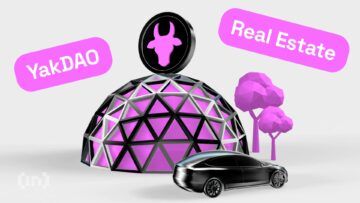While still one of the most heavily used networks in the space, Ethereum suffers from high transaction fees and confirmation times. This prevents it from its full vision of being a network for finance. To facilitate that vision, several projects have emerged with scaling solutions, and one of the most popular of those is rollup-based solutions.
One of these is Optimistic Ethereum, or Optimism as it’s more often known. This is a rollup scaling solution that greatly reduces gas fees and quickens transaction times.
In this article, we’ll look at Optimism, how it works, and what issues it promises to resolve. We’ll also compare it with competing solutions.
- What are Layer 2 solutions on Ethereum?
- How do Layer 2 solutions work?
- What is Optimism?
- What is a rollup?
- Optimism vs. Arbitrum: A detailed comparison
- Aribitrum and Optimism’s technical differences
- Is Polygon an alternative to Optimism?
- Is Optimism the future of the Ethereum network?
- Frequently asked questions
What are Layer 2 solutions on Ethereum?

Layer 2 (L2) refers to solutions used to scale applications by processing transactions from the Ethereum Mainnet (Layer 1) while maintaining the same principles of security and decentralization.
Due to the constantly increasing number of users using the Ethereum network, certain limitations have been created. Here the Ethereum L2 solutions need to make a difference.
Layer 2 solutions improve throughput (transaction speed) — moreover, they lower gas fees. Examples of Ethereum Layer 2 solutions are Immutable X, Arbitrum, Polygon, and Optimism.
For network performance issues, Ethereum Layer 2 scaling solutions can be vital. Many options for scaling Ethereum are in the testing phase. These use different methods for achieving the desired scalability. Ethereum seems to have two options to address this: Layer 2 and sharding. These solutions address the issues of transaction settlement delays, high transaction fees, and scalability.
How do Layer 2 solutions work?
Layer 2 solutions look to improve transactions done on the Ethereum network right now. Ethereum is indeed considering sharding as an option for the same issues. This would involve splitting the Ethereum network into multiple networks called “shards.” The realistic implementation of this is, however, a while away.
Layer 2 refers to a separate network that runs on top of Layer 1 or the main Ethereum network. Smart contracts keep the Layer 2 solutions on the Ethereum network. For interaction with the main network, these do not require any modifications to the base protocol. Ethereum Layer 2 scaling solutions provide different functions. These include off-chain computation or scalability for payments.
What is Optimism?

Optimism can support all of Ethereum’s Dapps. It does this by running the required computation off-chain, thereby increasing speed and decreasing costs. Transaction information is, however, recorded on the Ethereum blockchain.
Exchanges that use Optimism have registered a tremendous increase in transaction speeds. They have also noted a decrease in fees of over 100X. These benefits have not come at the expense of Ethereum’s own properties. It remains a decentralized and secure solution. In this respect, it’s a good attempt at creating scalability for the network.
Optimistic rollups don’t perform any mathematical equations. Instead, they confirm transactions by submitting information to the Ethereum Mainnet.
The JSON-RPC network specification appears just as on the Ethereum blockchain. Various companies make their APIs and Developer Tools available to be used as quick solutions for efficiently building on the Ethereum network.
Note that a variable cost controls Optimism’s capacity limitations. This mechanism used on Ethereum is similar to EIP-1559. Fees increase until transactions per hour fall below the limit.
Gas prices and the gas used in transactions can impact fees. Gas calculations on Optimism are more complex because they must account for execution cost and the cost of storing transaction data on L1 (also known as call data).
How does Optimism work?
The ultimate goal of Optimism is to make transactions on the prevalent Ethereum network more sustainable. But demand for ETH will also increase by reducing costs and increasing speeds. The network’s already thriving ecosystem (including money markets, user-friendly wallets, exchanges, yield aggregators, etc.) should facilitate increased growth.
Let’s also take a quick look at the technical aspects that allow for this to happen.
Sequencers used on Optimism execute calculations off-chain. They then publish compressed transaction data onto a smart contract on Ethereum at periodic checkpoints. Because computation is resource-intensive, it can be scaled by moving it off Ethereum.
Every time the sequencer publishes transaction information, there is a window in which anyone can run their computation to determine whether the transaction data is genuine. In other words, the verifier checks the information. The smart contract then validates the information. The verifier will receive part of the deposit as a reward for the effort, while the rest is burnt. Then a new sequencer checks the data registered on-chain.
Ultimately, the system provides an incentive for sequencers and verifiers. This will also make stakeholders on Optimism want to participate in verifying the sequencer data. However, it is worth pointing out that there is a seven-day lock-up period. After this has elapsed, users can withdraw their funds back to the Ethereum network.
In a nutshell, Optimism can run its Layer 2 scaling solutions by using both on-chain and off-chain computational capabilities. Various Ethereum applications can also run on Optimism. Users are left with quicker, cheaper transactions that encourage the Ethereum ecosystem to grow and thrive.
What is a rollup?
Rollup is a Layer 2 scaling technology. Rollups store contract state hashes on-chain along with transaction calls and arguments that are logged as calldata. The actual transaction computation takes place off-chain. This is the key to the proposed scaling solution.
Rollups execute transaction operations on the Ethereum blockchain, but still, post transaction data to Layer 1. As the transaction information is registered on the Ethereum blockchain, the rollups benefit from the same security measures available on Layer 1.
High performance is achieved by batching off-chain transactions into one on-chain state transition. Rollup security is guaranteed by the ability of the on-chain contract to verify the accuracy of state transitions. Optimistic Rollup is the most popular rollup approach. ZK-Rollup is another popular solution.
To ensure deterministic smart contracts execution between L1 & L2, Optimism uses the OVM (Optimistic virtual machine) to resolve any discrepancies. This is an EVM-compatible execution environment that can be used on Layer 2. This creates a smart contract called the execution manager. It acts as a virtual container for OVM contracts. It provides a function that makes functionality between L1 & L2 consistent.
Existing rollups

With the Optimistic Rollup, anyone can verify the information of the rollup blocks. They can then issue a dispute so that the on-chain contract is notified to execute the calldata and study the validity of the rollup blocks.
Optimistic Rollup has several advantages. It provides high throughput, reduces costs, and maintains security requirements. Furthermore, it allows for various Ethereum applications to function normally.
Zero-Knowledge Rollup is an alternative to Optimistic. It relies on ZK-SNARKS for block verification. It does not utilize on-chain disputes. The system, however, is more expensive. This makes a less practical solution for the moment.
Simply put, rollups take care of Ethereum transactions outside of Layer 1. However, once a consensus is reached, the data is registered on Layer 1. Rollups benefit from the security benefits of the Ethereum network. They help ensure the short and long-term scalability of the Ethereum network.
Optimism features
Optimism Layer 2 solutions are meant to ease the burden of the Ethereum network. There are two main features to make crypto adopters excited. Optimism allows almost instantaneous transactions. Transactions on the Ethereum blockchain are nearly ten times less expensive. Considering the volume of daily transactions, these are impressive features.
The Ethereum blockchain allows easy and flexible development of decentralized projects. The number of applications built on Ethereum is increasing rapidly. It’s no secret, however, that Ethereum’s success has also caused problems for the network. The sheer volume of transactions increases the time and costs required to confirm them.
The network can only process 10–15 transactions per second on average. This growth has led to high confirmation speeds and high fees. Optimism reduces the burden of these two issues. When it comes to the popular crypto exchange, Uniswap, transaction fees are reduced by 10 to 100 times. Similar tests have shown a decrease in fees of up to 143 times on the Synthetix Exchange.
The incentives provided by the Optimism Rollups help maintain the security of transactions. Each node in the network must put up a stake in order to suggest a new block. And each node has the power to challenge the validity of a transaction. The smart contract checks results on Layer 1 of Ethereum. The nodes are rewarded or lose the stake based on the result of the dispute.
In other words, Optimism proposes a scaling solution whereby the computation of transactions does not occur on Layer 1. Still, the on-chain confirmation ensures that Ethereum’s essential features are maintained.
How to use Optimism
The Optimism network is intuitive to use as per its design. The function itself features a wallet with a friendly user interface. Users can transfer Ethereum and other coins using this. Once the currency is transferred, it can be used as part of transactions conducted on Layer 2.
Here are the simple steps to using Optimism.
The first thing to remember is the issue that Optimism will solve. Especially in the heydays of games like Cryptokitties, which runs on the Ethereum blockchain, gained worldwide notoriety, transaction fees were very high. Furthermore, it takes a long time for the transaction to be confirmed.
First, visit the Optimism website.
Next, connect your wallet from the allowed list of wallet providers. In our example, we will choose MetaMask. This is the most commonly used wallet for Ethereum transactions.
You can then make a deposit. Once received, the network will begin depositing your digital assets to Optimistic Ethereum.
You will need to confirm the transaction, including the gas fee, when conducting the operation.
And, you’re done! The process shouldn’t take more than a few minutes.
The great news is that now you can interact with Ethereum protocols just as you would on the mainnet. Best of all, you will have saved money, and you will benefit from the same security features available on the Ethereum network.
Note, that you can also withdraw to the Ethereum network by using Optimism.
When doing this, you will confirm the change of the network on your wallet. The withdrawal process will be made through either Optimism or Hop Exchange.
Optimism vs. Arbitrum: A detailed comparison
Optimism is not the only existing rollup solution. Two other networks that offer similar solutions are Arbitrum and Polygon. In terms of functionality and popularity, Arbitrum is the closest alternative to Optimism. Let’s take a look at the biggest differences and similarities between the two.
Arbitrum is a Layer 2 solution that enhances the capabilities of Ethereum smart contracts. It focuses on increasing the speed and scalability of smart contracts while adding additional privacy features.
Arbitrum allows developers to run EVM contracts unmodified and Ethereum transactions on a secondary layer while still enjoying Ethereum’s Layer 1 security. In these aspects, it offers very similar features to Optimism.
The main difference between Optimism and Arbitrum is that the former uses single-round fraud proofs, while Arbitrum uses multiple-round ones. Optimism’s single round fraud-proof (FP) relies on L1 to execute all L2 transactions. This ensures that the verification of FP is immediate.
Aribitrum and Optimism’s technical differences

Similar to Optimism, Arbitrum also uses transaction rollups to store batches of transactions submitted to the Ethereum mainchain. The sidechain can be used to execute these transactions at a low cost while still leveraging Ethereum to guarantee correct results. This allows Ethereum to reduce its storage and computational burden. It also enables Layer 2 DApps.
Arbitrum uses the Arbitrum Virtual Machine (AVM), while Optimism uses the Ethereum Virtual Machine (EVM). This is a virtual sandbox that includes network consensus rules for each Ethereum node used in executing smart contracts. In other words, Optimism requires a greater connection with the Ethereum network.
In a nutshell, currently, there is no scalable solution that addresses all issues of the Ethereum network. Arbitrum primarily looks to improve the functionality of Ethereum smart contracts. Optimism does the same but focuses heavily on reducing the cost of transactions.
Is Polygon an alternative to Optimism?
When speaking about Ethereum scalable solutions, the Polygon crypto network is also worth discussing.
Polygon is also a Layer 2 scaling solution. It provides tools for developers to build scalable, decentralized finance applications. These Dapps are able to prioritize security, performance, and user experience (UX).
Polygon is a multi-chain platform that combines the best aspects of Ethereum and other blockchains. Polygon addresses several issues associated with the Ethereum blockchain, including high gas fees and slow transaction speeds. It does this without compromising security. This multi-chain system works in the same way as other systems like Cosmos, Polkadot, and Avalanche.
Polygon and Ethereum’s functionalities and principles are similar. It benefits from a high level of security. It also encourages collaboration with community participants, as much of the code it uses is open source.
Is Optimism the future of the Ethereum network?
Presently, it is impossible to argue against the importance of the Optimism network. Its services allow the highly popular Ethereum network to be scalable. This means that transactions can be handled in an affordable and timely manner.
Those who used the Ethereum blockchain in the past know the challenges faced when executing transactions. Rollup solutions have helped ease the burden of cost and time.
Furthermore, Optimism allows for collaboration and improvements performed by community members. Decentralized applications can run on Optimism and benefit from the same features as on the Ethereum network.
The network’s consistent development, along with the increased adoption of ETH, will likely make Optimism one of the notable crypto-projects of the future.
Frequently asked questions
What is Ethereum Optimism?
Is Optimism safe?
How do you use Ethereum Optimism?
Will Ethereum Optimism have a token?
How do you get ETH on Optimism?
Does Optimism have a coin?
Trusted
Disclaimer
In line with the Trust Project guidelines, the educational content on this website is offered in good faith and for general information purposes only. BeInCrypto prioritizes providing high-quality information, taking the time to research and create informative content for readers. While partners may reward the company with commissions for placements in articles, these commissions do not influence the unbiased, honest, and helpful content creation process. Any action taken by the reader based on this information is strictly at their own risk. Please note that our Terms and Conditions, Privacy Policy, and Disclaimers have been updated.




